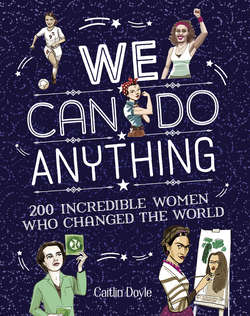Читать книгу We Can Do Anything: From sports to innovation, art to politics, meet over 200 women who got there first - Chuck Gonzales, Caitlin Doyle - Страница 23
ОглавлениеDOROTHEA LANGE INFLUENTIAL DOCUMENTARIAN AND PHOTOJOURNALIST
FULL NAME: Dorothea Margaretta Nutzhorn Lange
BORN: MAY 26, 1895, HOBOKEN, NEW JERSEY, U.S.A
DIED: OCTOBER 11, 1965, SAN FRANCISCO, CALIFORNIA, U.S.A.
NATIONALITY: AMERICAN
“America Survives the Depression,” a 1998 U.S. postage stamp, features Dorothea’s iconic 1936 “Migrant Mother” photograph.
TOP OF HER GAME
Among famous photographers, Dorothea Lange ranks right at the top, alongside Ansel Adams, Henri Cartier-Bresson, and Annie Leibovitz. Dorothea’s black-and-white photographs of America’s Great Depression and Dust Bowl of the 1930s helped create the genre of documentary photography we know today.
At the age of seven, Dorothea contracted polio, a potentially fatal infectious disease that affects the muscles. Dorothea survived, but her right leg was badly affected, which left her with a permanent limp. However, she believed this condition helped form the person she would become. Dorothea studied photography at Colombia University, and in her early 20s she set out to travel the world. She only got as far as San Francisco—but her thwarted plans would result in some of the most iconic images of America in history. For a time, Dorothea ran a portrait studio in San Francisco, but then the Great Depression hit. This was a time of severe economic depression, with hardship, high unemployment, and widespread poverty. The Depression started in the U.S.A. after a fall in prices on the stock market, before reaching around the globe.
THE STORY BEHIND THE PHOTOGRAPH
Dorothea saw what was happening around her and decided to take her camera to the streets. She began documenting the struggles around her: soup kitchens, unemployed workers, and starving families. She was hired by the U.S. government’s Resettlement Administration (later the Farm Security Administration) to capture daily life in America. Dorothea’s most iconic photo—and arguably the most famous photo of American life—is called “Migrant Mother,” taken in 1936. It shows children huddled around their young mother, a portrait of complete despair. This photo made the public realize the Depression’s very real impact and also raised the bar of documentary photography. The photograph prompted the U.S. government to rush aid to its people. In 1940, Dorothea won the very prestigious Guggenheim fellowship—the first woman to do so. She was gifted at making the people she photographed feel respected and listened to. Her work made a significant difference to the lives of many.
With the start of World War II, Dorothea was again hired by the U.S. government. This time it was to take photos of Japanese Americans who had been put into “detention camps” (prisons for whole groups of people for “security” during wartime). These photographs were so critical of the government, the Army kept them hidden from view for decades. Dorothea traveled widely for the rest of her life, and she went on to document the lives of people from as far afield as Utah to Vietnam, Ireland to Pakistan.
Dorothea Lange’s work forever changed the course of photojournalism: she was able to give her stories heart. Her work continues to influence the work of photographers around the globe to this day.
Dorothea documented the hardships faced by the American people. In this 1937 photograph, she shows cotton sharecroppers toiling on the land in Greene County, Georgia.
